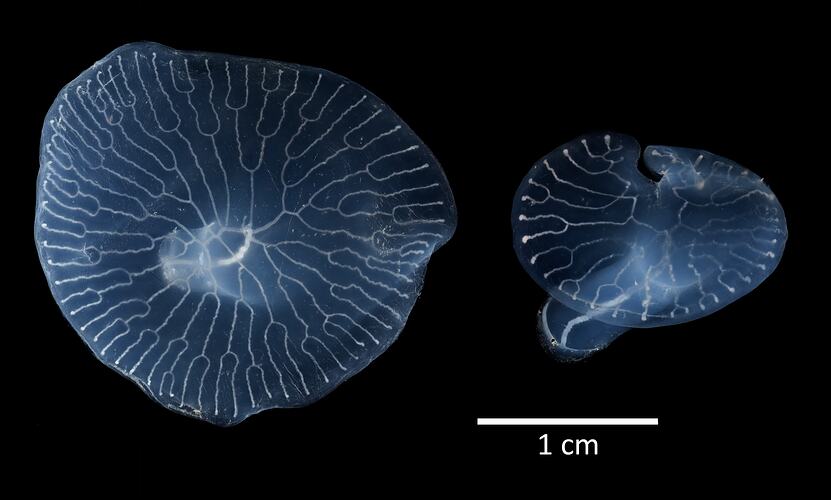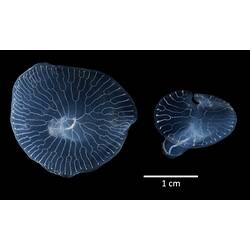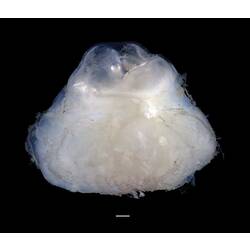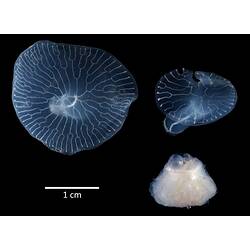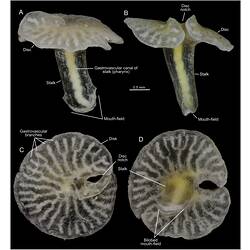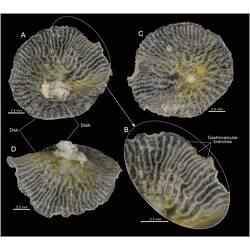When Dendrogramma was described in 2014 it was so unusual that nobody could work out exactly what it was. It was assigned the status Metazoa incertae sedis meaning it was a multicellular animal with uncertain relationship to any other animals. Beyond being an animal it wasn't at all obvious what it was from the specimens that were available. Dendrgoramma was so interesting that it was voted one of the top-ten new species of the year by the International Institute for Species Exploration.
The scientists who described Dendrogramma could say that it was a non-bilaterian animal, meaning that it did not have left-right symmetry or distinct front and back ends like the majority of known animals do. Did this mean that it belonged to one of the non-bilaterian phyla such as the cnidarians (jellyfish, anemones and corals) or ctenophores (comb jellies)? Dendrogramma was so mysterious that it was suggested it could be a previously unknown phylum.
Phyla are one of the highest level of taxonomic groups and are based on similarity of general body plan of the organisms within them. If Dendrogramma did belong to a new phylum it would mean its structure was really different from any other organism found before. This would be a big deal; although new species are being discovered all the time, only a few new phyla have been discovered in the last century and we think we've got a pretty good idea of the higher taxonomic levels of life on Earth.
One of the reasons the specimens of Dendrogramma couldn't be described as belonging to any known group was the fact that when they were collected in 1986 they were preserved in formalin before being transferred into ethanol. Formalin preserves the specimen but makes it almost impossible to extract DNA for analysis and comparison with known animals. Without more specimens it would be impossible to solve the puzzles of what sort of animal Dendrogramma is.
In November 2015 scientists on a research cruise on the RV Investigator off South Australia as part of the Great Australian Bight Deepwater Marine Program collected 85 new Dendrogramma specimens. One of the scientists on board recognised them and made sure they were preserved in a way that would allow genetic data to be extracted from the specimens later. When the cruise ended a team of Museum Victoria scientists were then able to extract genetic material from some of the specimens.
Using DNA and RNA sequences the team worked out that Dendrogramma belongs to a group of animals called Siphonophores; a bizarre group of colonial Cnidarians with elaborate arrangements of specialised body parts. This means that Dendrogramma is closely related to the Blue-bottle (or Portuguese Man-of-war), though they live at much greater depths, closer to the sea floor instead of floating at the surface.
Knowing this the team was able to tell that the Dendrogramma specimens collected in 1986 and 2015 are not a whole animal. Instead they're structures called bracts. They would have been attached to a central structure when the animal was alive and are possibly used for defence. An orange gas-filled structure that looked like the floats (called pneumatophores) known from other Siphonophores was also collected on the Investigator cruise at the same location as some of the new bract specimens. DNA from this was found to be identical to that taken from the bracts at the same site, confirming they are the same species.
The original description of Dendrogramma included two species that had slightly different shapes and sizes; enigmatica and discoides. The new specimens collected in 2015 demonstrate that instead of being two species of different sizes they are all bracts from one species, possibly specialised for different purposes. All of the known specimens are therefore now called Dendrogramma enigmatica as that was the species that was named first.
Though we now know that Dendrogramma fits within a phylum we already knew it is still unusual. For instance, the distinctive bracts are several times bigger than those of its relatives. It is also clear that these delicate colonial specimens have been damaged in the transit from the sea floor. Just how the colonies fit together and what they look like are still a mystery. Hopefully someday equipment like underwater cameras or submarines will allow us to see one in its natural environment and solve this last piece of the puzzle.
More Information
-
Keywords
-
Authors
-
Article types
